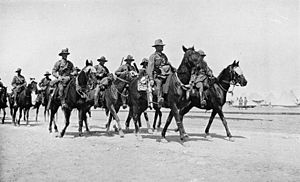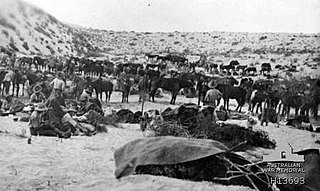
The Battle of Romani was the last ground attack of the Central Powers on the Suez Canal at the beginning of the Sinai and Palestine campaign during the First World War. The battle was fought between 3 and 5 August 1916 near the Egyptian town of Romani and the site of ancient Pelusium on the Sinai Peninsula, 23 miles (37 km) east of the Suez Canal. This victory by the 52nd (Lowland) Division and the Anzac Mounted Division of the Egyptian Expeditionary Force (EEF) over a joint Ottoman and German force, which had marched across the Sinai, marked the end of the Defence of the Suez Canal campaign, also known as the Offensive zur Eroberung des Suezkanals and the İkinci Kanal Harekâtı, which had begun on 26 January 1915.
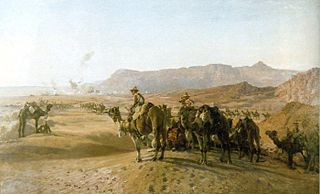
The Battle of Magdhaba took place on 23 December 1916 during the Defence of Egypt section of the Sinai and Palestine Campaign in the First World War. The attack by the Anzac Mounted Division took place against an entrenched Ottoman Army garrison to the south and east of Bir Lahfan in the Sinai desert, some 18–25 miles (29–40 km) inland from the Mediterranean coast. This Egyptian Expeditionary Force (EEF) victory against the Ottoman Empire garrison also secured the town of El Arish after the Ottoman garrison withdrew.

The Australian and New Zealand Mounted Division was a mounted infantry division of the British Empire during the First World War. The division was raised in March 1916 and was assigned to the I ANZAC Corps. On establishment, it consisted of four brigades comprising three Australian Light Horse and one New Zealand mounted rifles, supported by British horse artillery. In 1917, one of the Australian brigades was replaced by a British yeomanry brigade. After April 1917, the standard order of battle was reduced to two Australian brigades and one New Zealand brigade, although the Imperial Camel Corps Brigade and other British mounted brigades were temporarily attached several times during operations.
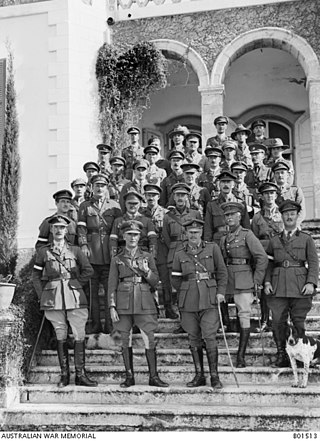
The Desert Mounted Corps was an army corps of the British Army during the First World War, of three mounted divisions renamed in August 1917 by General Edmund Allenby, from Desert Column. These divisions which served in the Sinai and Palestine Campaign had been formed by Australian light horse, British yeomanry, and New Zealand mounted rifles brigades, supported by horse artillery, infantry and support troops. They were later joined by Indian cavalry and a small French cavalry detachment.

The Battle of Rafa, also known as the Action of Rafah, fought on 9 January 1917, was the third and final battle to complete the recapture of the Sinai Peninsula by British forces during the Sinai and Palestine campaign of the First World War. The Desert Column of the Egyptian Expeditionary Force (EEF) attacked an entrenched Ottoman Army garrison at El Magruntein to the south of Rafah, close to the frontier between the Sultanate of Egypt and the Ottoman Empire, to the north and east of Sheikh Zowaiid. The attack marked the beginning of fighting in the Ottoman territory of Palestine.

The First Battle of Gaza was fought on 26 March 1917 during the first attempt by the Egyptian Expeditionary Force (EEF), which was a British Empire military formation, formed on 10 March 1916 under the command of General Archibald Murray from the Mediterranean Expeditionary Force and the Force in Egypt (1914–15), at the beginning of the Sinai and Palestine Campaign of the First World War. Fighting took place in and around the town of Gaza on the Mediterranean coast when infantry and mounted infantry from the Desert Column, a component of the Eastern Force, attacked the town. Late in the afternoon, on the verge of capturing Gaza, the Desert Column was withdrawn due to concerns about the approaching darkness and large Ottoman reinforcements. This British defeat was followed a few weeks later by the even more emphatic defeat of the Eastern Force at the Second Battle of Gaza in April 1917.

The Battle of Beersheba was fought on 31 October 1917, when the British Empire's Egyptian Expeditionary Force (EEF) attacked and captured the Yildirim Army Group garrison at Beersheba, beginning the Southern Palestine Offensive of the Sinai and Palestine campaign of World War I. Infantry from the 60th (London) and the 74th (Yeomanry) Divisions of the XX Corps from the southwest conducted limited attacks in the morning, then the Anzac Mounted Division launched a series of attacks against the strong defences which dominated the eastern side of Beersheba, resulting in their capture during the late afternoon. Shortly afterwards, the Australian Mounted Division's 4th and 12th Light Horse Regiments conducted a mounted infantry charge with bayonets in their hands, their only weapon for mounted attack, as their rifles were slung across their backs. Part of the two regiments dismounted to attack entrenchments on Tel es Saba defending Beersheba while the remainder of the light horsemen continued their charge into the town, capturing the place and part of the garrison as it was withdrawing.

The Second Battle of Gaza was fought on 17–19 April 1917, following the defeat of the Egyptian Expeditionary Force (EEF) at the First Battle of Gaza in March, during the Sinai and Palestine Campaign of the First World War. Gaza was defended by the strongly entrenched Ottoman Army garrison, which had been reinforced after the first battle by substantial forces. They manned the town's defences and a line of strong redoubts which extended eastwards along the road from Gaza to Beersheba. The defenders were attacked by the Eastern Force's three infantry divisions, supported by two mounted divisions, but the strength of the defenders, their entrenchments & supporting artillery decimated the attackers.
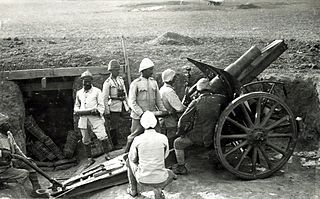
The Sinai and Palestine campaign of the Middle Eastern theatre of World War I was fought by the Arab Revolt and the British Empire, against the Ottoman Empire and its Imperial German allies. It started with an Ottoman attempt at raiding the Suez Canal in 1915, and ended with the Armistice of Mudros in 1918, leading to the cession of Ottoman Syria.

The New Zealand Mounted Rifles Brigade was a brigade of the New Zealand Army during the First World War. Raised in 1914 as part of the New Zealand Expeditionary Force, it was one of the first New Zealand units to sail for service overseas.

The Canterbury Mounted Rifles Regiment was a mounted infantry regiment from New Zealand, raised for service during the First World War. It was assigned to the New Zealand Mounted Rifles Brigade, and formed part of the New Zealand Expeditionary Force.

The Wellington Mounted Rifles Regiment was a mounted infantry regiment from New Zealand, raised for service during the First World War. It was assigned to the New Zealand Mounted Rifles Brigade, part of the New Zealand Expeditionary Force.

The Battle of Katia, also known as the Affair of Qatia by the British, was an engagement fought east of the Suez Canal and north of El Ferdan Station, in the vicinity of Katia and Oghratina, on 23 April 1916 during the Defence of the Suez Canal Campaign of World War I. An Ottoman force led by the German General Friedrich Freiherr Kress von Kressenstein made a surprise attack on three and a half squadrons of the British 5th Mounted Brigade, which was widely scattered to the east of Romani. The mounted brigade had been ordered to the area to protect the new railway and water pipeline being built from Kantara on the Suez Canal, as this infrastructure extended out past the Canal's zone of defences into the Sinai Peninsula towards Romani. Kress Von Kressenstein's attack was completely successful, decimating the equivalent of little more than a regiment. On the same day, an associated Ottoman attack on Duidar, very close to the Suez Canal, failed when it met with strong British opposition.
The Capture of Jericho occurred between 19 and 21 February 1918 to the east of Jerusalem beginning the Occupation of the Jordan Valley during the Sinai and Palestine Campaign of the First World War. Fighting took place in an area bordered by the Bethlehem–Nablus road in the west, the Jordan River in the east, and north of a line from Jerusalem to the Dead Sea. Here a British Empire force attacked Ottoman positions, forcing them back to Jericho and eventually across the Jordan River.

The Second Battle of Amman was fought on 25 September 1918 during the Third Transjordan attack as part of the Battle of Nablus which together with the main Battle of Sharon form the major set piece offensive known as the Battle of Megiddo of the Sinai and Palestine Campaign in World War I. After cutting the road from Nablus to Es Salt on 22 September Chaytor's Force captured the bridge over the Jordan River at Jisr ed Damieh while units of the Seventh Army and remnants of the Eighth Army were still in retreating towards the bridge from the Judean Hills. Having cut this line of retreat, Chaytor's Force proceeded eastwards to attack and capture Es Salt, before riding on to attack and capture the Ottoman rearguard of the Fourth Army defending Amman. These British Empire victories of the Third Transjordan attack over Yildirim Army Group forces, followed two unsuccessful EEF attacks across the Jordan River in March and April 1918.

The Battle of Ayun Kara was an engagement in the Sinai and Palestine Campaign during the First World War. The battle was fought between the New Zealand Mounted Rifles Brigade and a similar-sized rearguard from the Turkish 3rd Infantry Division, which was part of the XXII Corps of the Ottoman Eighth Army under Kress von Kressenstein.

The third attack on Anzac Cove was an engagement during the Gallipoli Campaign of the First World War. The attack was conducted by the forces of the Ottoman Turkish Empire, against the forces of the British Empire defending the cove.

The Raid on Jifjafa was a long range pre-emptive operation by a composite formation of the British Empire against Ottoman forces at the Jifjafa well in the Sinai Desert. It was part of the Sinai and Palestine Campaign of World War I.

The battle for No.3 Post was fought during the Gallipoli Campaign in the First World War, between the forces of the New Zealand Mounted Rifles Brigade and the Turkish 19th Division.
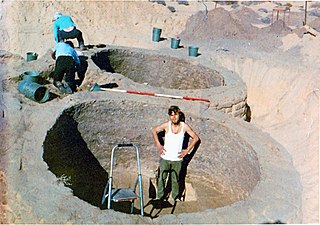
Bir al-Abed is one of the cities of North Sinai in the north east of Egypt. It is the capital of Bir al-Abd Markaz, located on the international coastal road on the shores of Lake Bardawil.
